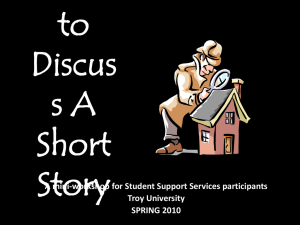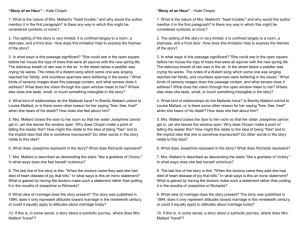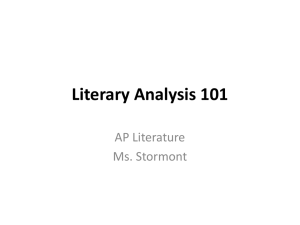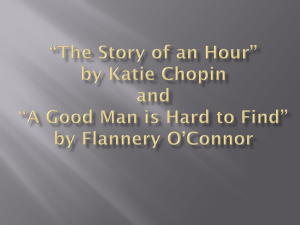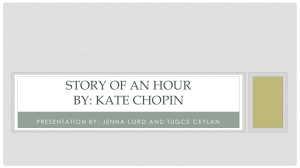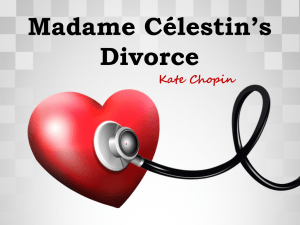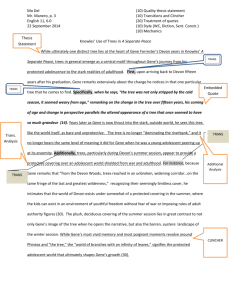5.2 The forbidden joy of independence
advertisement
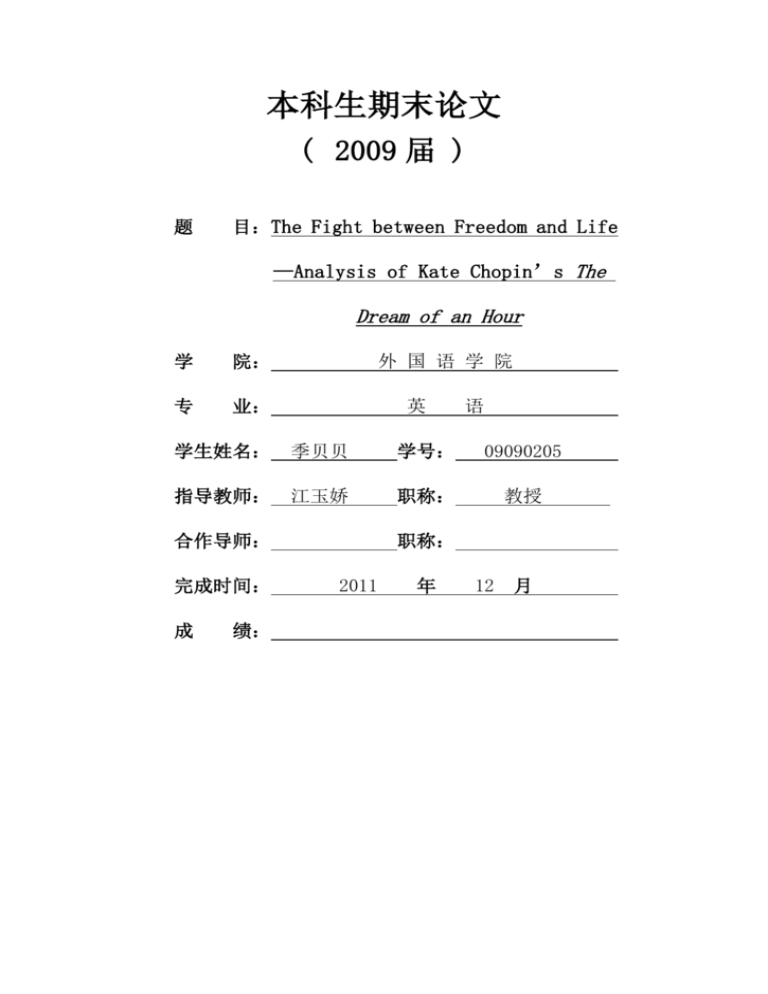
本科生期末论文 ( 2009 届 ) 题 目:The Fight between Freedom and Life —Analysis of Kate Chopin’s The Dream of an Hour 学 院: 专 业: 外 国 语 学 院 英 语 学生姓名: 季贝贝 学号: 09090205 指导教师: 江玉娇 职称: 教授 合作导师: 完成时间: 成 绩: 职称: 2011 年 12 月 The fight between freedom and life —Analysis of Kate Chopin’s The Dream of an Hour 浙江师范大学美国文学期末论文正文 目 录 Abstract: ......................................................................................................2 1. Introduction .............................................................................................3 2. Symbolism in the Story of an Hour ........................................................3 3. Major Themes .........................................................................................5 3.1 Appearance vs. Reality: ..................................................................5 3.2 Marriage vs. Freedom: ....................................................................5 4. Analysis of Major Character ...................................................................5 5. The reasons of Ms Mallard’s death .........................................................6 5.1 Oppression of the society................................................................6 5.2 The forbidden joy of independence ................................................6 5.3 The inherent oppressiveness of marriage .......................................7 6. Conclusion ..............................................................................................7 Reference ....................................................................................................8 1 The fight between freedom and life —Analysis of Kate Chopin’s The Dream of an Hour The Fight between Freedom and Life —Analysis of Kate Chopin’s The Dream of an Hour Ji Beibei Abstract: The Dream of an Hour, first published on December 6, 1894, in Vogue magazine, is a short story written by Kate Chopin (1851-1904) who is an American writer of short stories and novels. The story, set in the house of Mr. Mallard, unfolds a one-hour span of life,from spiritually reborn to physically death, of Ms Mallard. This paper also explores the symbolism, major themes, major character and the reasons of Ms Mallard’s death. Key words: symbolism, themes, character, reasons 2 The fight between freedom and life —Analysis of Kate Chopin’s The Dream of an Hour The Fight between Freedom and Life —Analysis of Kate Chopin’s The Dream of an Hour FLC 2011(12)(English)Ji Beibei Tutor: Jiang Yujiao 1. Introduction The Story of an Hour is a short story written by Kate Chopin on April 19, 1894, and published in Vogue on December 6, 1894. Initially, it was written and first published under the title “The Dream of an Hour.” It was reprinted in St. Louis Life on January 5, 1895. The title of the short story refers to the time elapsed between the moments at which the protagonist, Mrs. Mallard, hears that her husband is dead and discovers that he is alive after all. The Story of an Hour was considered controversial during the 1890s because it deals with a female protagonist who feels liberated by the news of her husband’s death. However, she had one more surprise waiting her before her excitement came to an end. 2. Symbolism in The Dream of an Hour Chopin eloquently laces The Dream of an Hour with vivid symbols to accentuate the contrasting segments and offset social paradigms, enchanting the reader to perceive the situation from her slant. Employing strong irony in a nearly satirical fashion, Chopin utilizes vivacious descriptions as a literary tool to portray the unexpected and coerce the reader to their own conclusions, instead of explicitly stating them. Her masterful crafting of graphic illustrations, employed at the appropriate places, brings a revitalizing light to the story. At the beginning of the story, the heart is traditionally a symbol of an individual’s emotional core. The first sentence of The Dream of an Hour informs us that Mrs. Mallard has heart troubles. Her physical heart problems symbolize her emotional heart problems as it relates to marriage. The heart of any society is the family and a marriage between a man and a woman is the essential foundation of the family. Mrs. Mallard’s heart troubles may represent the peril in which the late 19th century institution of marriage finds itself on account of the inequalities therein. The next important sign of symbolism is the arm chair Mrs. Mallard often sits in. The chair represents a relaxation period from her oppressive life. Mrs. Mallard sinks into the chair after the death if her husband. The position of the chair in the house is also important. This displays a warm feeling of security because the chair is facing the window. This depicts life as a warmer place than death. The description words used to describe the chair further lets the reader get a feeling or love and warmth. 3 The fight between freedom and life —Analysis of Kate Chopin’s The Dream of an Hour Another sign of symbolism is the open window in Mrs. Mallard’s bedroom. The window represents the new opportunities she will have in her life after her husband’s death. The outside scene depicts a perfect day with beautiful skies filled with big clouds. The big sun as well as they birds and people singing also add to the perfect setting of happiness. The opening window also means that there is more space for her and the world is more beautiful than she imagined. The open window plays a significant role in Mrs. Mallard’s life. Moreover, the spring day symbolizes a new beginning of her life in which she is free. It also represents rebirth and new life. Spring is the time when living things propagate and are reborn. Likewise, Louise believes she will become productive, energized and reborn. Louise has her whole life of freedom to look forward to. And she sees the trees that “were all quiver with the new spring life” symbolizing also something new happening in her life. The rain represents revival from Mrs. Mallard’s downfall period. Rain also represents calmness in her hectic life. It seems that all the birds are singing and the nature and human are in a harmonious situation. Mrs. Mallard notices “patches of blue sky showing here and there through the clouds.” This imagery is bursting with metaphorical connotation. The blue sky, symbolizing serenity and delight, is starting to appear through the clouds, symbolizing the last pieces of the turbulent storm in the previous scene. This also reinforces the reader’s assumption that a bizarre joy is emerging. The clouds and sky continue to play off the weather theme, acting as a guide to her mindset. Like most other imagery in the story, this landscape is directly metaphorical of Mrs. Mallard, with her happiness beginning to show through her preceding anguish. Previously, Mrs. Mallard longed for her life to end, thinking there would be nothing but restrictions. Now that end seems full of hope and joy. Chopin continues to strengthen her illustrative ties in the eighth paragraph, describing Mrs. Mallard’s “young” face with “dull [eyes] whose gaze was fixed away off yonder on one of those patches of blue sky.” The word “young” is a concrete reference to her childhood-like state- with the dull gaze emphasizing her overwhelmed condition. The “patches of blue sky” revisits the reader here, continuing the weather theme, while demonstrating a yearning for that happiness. This scene mirrors a youthful school-aged child staring out the window, wishing he wasn’t sitting in a classroom. The child wants to play outside instead of working on English assignments all day, and Mrs. Mallard, like a young child, craves escaping her captivity and enjoying life as well. The “lines” indicates that she is young but has lived in a repressed life for a long time. In the tenth paragraph, the “hands” used to be powerless and controlled by her husband. But now her hands are powerful again. Can we imagine how hard to get free from man? Then, Mrs. Mallard engages in a graphic fruitless attempt to battle back that feeling, “striving to beat it back with her will,” ironic and juvenile since she hungers for her opposition, however quickly abandoned when “a little whispered word escaped her slightly parted lips . . . free.” And there was light. The entire story from the beginning up to this point is summarized into one word: “free.” The word free today symbolically stands against any despotism and injustice, the very same evils the reader speculated earlier. This confirms her gloomy past, and explains the use of such intense positive imagery after receiving the news of her husband’s death. Chopin stuffs the Dream of an Hour with strong symbols to effectively illustrate the vast unexpected twists she pulls off. From sarcasm to devastation, every graphical description helps entice the reader and pull them closer to the center cords of the story. As a master of prose, Chopin 4 The fight between freedom and life —Analysis of Kate Chopin’s The Dream of an Hour does not leave any reader in the metaphorical dark. 3. Major Themes 3.1 Appearance vs. Reality: Mrs. Mallard is aware of how she must conduct herself as someone whose husband just passed away. Her true feelings is that she is happy her husband is now gone – but her conduct says otherwise. She puts on an act that would be a typical response upon hearing the death of her spouse. However, the narrator notes that she was quick to accept the death with any questions. “She did not hear the story as many women have heard the same, with a paralyzed inability to accept its significance.” She then goes upstairs and keeps herself away from everyone else in order to make it seem as if she was coping. In reality, she is overjoyed at the loss of her husband. Even Louis is shocked at her behavior and wonders if her reaction was beyond the norm. “She did not stop to ask if it were or were not a monstrous joy that held her.” 3.2 Marriage vs. Freedom: Mrs. Mallard believes that both women and men limit each other in matrimony. She does not express any apparent ill-will against Mr. Mallard and has even admitted to liking him and some point. Due to its structure as telling the story within an hour’s time, no background information is given about Mr. and Mrs. Mallard’s relationship. This is an effective style that Chopin utilizes. The story is not about the husband being abusive to his wife or vice-versa. Instead, it focuses on the individual’s inner desires for freedom. The point-of-view of “Story of an Hour” is that of the wife. Louise’s desire for freedom far exceeds her love for him - a controversial idea that goes against the norms of society. She would rather live freely than be in a marriage that subjects her to domesticity. “There would be no powerful will bending hers in that blind persistence with which men and women believe they have a right to impose a private will upon a fellow-creature.” The idea of Marriage vs. Freedom is a growing theme in modern American Women Writing during Kate Chopin’s time. The idea that women can look beyond marriage as their lifelong goal to achieve is a teetering idea for women seeking independence. 4. Analysis of Major Character An intelligent, independent woman, Louise Mallard understands the “right” way for women to behave, but her internal thoughts and feelings are anything but correct. When her sister announces that Brently has died, Louise cries dramatically rather than feeling numb, as she knows many other women would. Her violent reaction immediately shows that she is an emotional, 5 The fight between freedom and life —Analysis of Kate Chopin’s The Dream of an Hour demonstrative woman. She knows that she should grieve for Brently and fear for her own future, but instead she feels elation at her newfound independence. Louise is not cruel and knows that she’ll cry over Brently’s dead body when the time comes. But when she is out of others’ sight, her private thoughts are of her own life and the opportunities that await her, which she feels have just brightened considerably. Louise suffers from a heart problem, which indicates the extent to which she feels that marriage has oppressed her. The vague label Chopin gives to Louise’s problem—“heart trouble”—suggests that this trouble is both physical and emotional, a problem both within her body and with her relationship to Brently. In the hour during which Louise believes Brently is dead, her heart beats strongly—indeed, Louise feels her new independence physically. Alone in her room, her heart races, and her whole body feels warm. She spreads her arms open, symbolically welcoming her new life. “Body and soul free!” she repeats to herself, a statement that shows how total her new independence really is for her. Only when Brently walks in does her “heart trouble” reappear, and this trouble is so acute that it kills her. The irony of the ending is that Louise doesn’t die of joy as the doctor’s claim but actually from the loss of joy. Brently’s death gave her a glimpse of a new life, and when that new life is swiftly taken away, the shock and disappointment kill her. Keeping in mind the above examples of an ailing heart, Mrs. Mallard could be said to represent women of her time period who were unable to find happiness in marriage and motherhood, not because it's not found there, but because their freedoms within marriage are restricted. 5. The reasons of Ms Mallard’s death 5.1 Oppression of the society Society in late nineteenth century expected women to keep house, cook, bear and rear children—but little more. Despite efforts of women’s-rights activists such as Lucretia Mott, Elizabeth Cady Stanton, and Susan B. Anthony, women still had not received the right to vote in national elections by the century’s end. Moreover, employers generally discriminated against women by hiring them for menial jobs only and paying them less than men for the same work. The Story of an Hour hints that Mrs. Mallard’s husband—perhaps a typical husband of his day—dominated his wife. But oppression of the society made her feel her guilty feeling of her evil ideas, which induced her heart to fail. 5.2 The forbidden joy of independence In “The Story of an Hour,” independence is a forbidden pleasure that can be imagined only privately. When Louise hears from Josephine and Richards of Brently’s death, she reacts with obvious grief, and although her reaction is perhaps more violent than other women’s, it is an appropriate one. Alone, however, Louise begins to realize that she is now an independent woman, a realization that enlivens and excites her. Even though these are her private thoughts, she at first 6 The fight between freedom and life —Analysis of Kate Chopin’s The Dream of an Hour tries to squelch the joy she feels, to “beat it back with her will.” Such resistance reveals how forbidden this pleasure really is. When she finally does acknowledge the joy, she feels possessed by it and must abandon herself to it as the word free escapes her lips. Louise’s life offers no refuge for this kind of joy, and the rest of society will never accept it or understand it. Extreme circumstances have given Louise a taste of this forbidden fruit, and her thoughts are, in turn, extreme. She sees her life as being absolutely hers and her new independence as the core of her being. Overwhelmed, Louise even turns to prayer, hoping for a long life in which to enjoy this feeling. When Brently returns, he unwittingly yanks Louise’s independence away from her, putting it once again out of her reach. The forbidden joy disappears as quickly as it came, but the taste of it is enough to kill her. 5.3 The inherent oppressiveness of marriage Chopin suggests that all marriages, even the kindest ones, are inherently oppressive. Louise, who readily admits that her husband was kind and loving, nonetheless feels joy when she believes that he has died. Her reaction doesn’t suggest any malice, and Louise knows that she’ll cry at Brently’s funeral. However, despite the love between husband and wife, Louise views Brently’s death as a release from oppression. She never names a specific way in which Brently oppressed her, hinting instead that marriage in general stifles both women and men. She even seems to suggest that she oppressed Brently just as much as he oppressed her. Louise’s epiphany in which these thoughts parade through her mind reveals the inherent oppressiveness of all marriages, which by their nature rob people of their independence. When her husband appeared, her despair at the thought that she was thrown back to the old way of life induced her heart to fail. 6. Conclusion The story of an hour unveils in half concealing the inequality between men and women in late 19th century where women are depressed under the man-oriented society ,and the heroine well reflects the typical image of woman in that period of time. It also exemplified Chopin’s beliefs about women’s roles in marriage and feminine identity. Personally, I’m quite fond of this delicate story. A few lines weave a full picture of a woman’s whole life, simple but profound. This is a fight between freedom and life. Ms Mallard’s death is not only incidental, but also inevitable. She is flabby. The death is not her positive action to fight for freedom, but is unconsciousness. However, the fight is fated behind the success and could not be tolerant by the society. Having enjoyed one hour’s freedom, she had no choice but die. Only in this way can she completely get rid of constraint and gain freedom. All in all, I recall Petofi Sandor’s famous words: “Life is dear, love is dearer. Both can be given up for freedom.” 7 The fight between freedom and life —Analysis of Kate Chopin’s The Dream of an Hour Reference 1. 申丹. 叙事文本与意识形态——— 对凯特·肖邦《一小时的故事》的重新评 价[A]. 外国文学评论[J],2004 (01): 102-103. 2. 戴祝君 Clues to “the Monstrous Joy” of Mrs. Mallard In“ The Story of an Hour ” 上海外国语大学 江苏大学 3. 孙胜忠 反讽、象征与女性意识评凯特#肖帮的短篇小说 5 一小时的变故 6 和 5 暴风雨 6 安徽师范大学 2003 年第 5 期( 总第 96 期) 4. 宋雪 凯特·肖邦小说《一小时的故事》的女性主义解读沈阳农业大学学报(社 会科学版),2010-01,12(1):110-112 5. www.wikipedia.com 8
